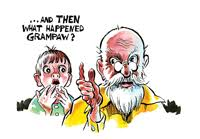 QUOTABLE QUOTES
QUOTABLE QUOTES
Send us your Quotable Quotes-retiredreunionmgr@navalhelicopterassn.org
The thing is, helicopters are different from planes. An airplane by its
nature wants to fly, and if not interfered with too strongly by unusual events
or by a deliberately incompetent pilot, it will fly. A helicopter does not want
to fly. It is maintained in the air by a variety of forces and controls working
in opposition to each other, and if there is any disturbance in this delicate
balance, the helicopter stops flying, immediately and disastrously. There
is no such thing as a gliding helicopter.
That is why being a helicopter pilot is so different from being an air-
plane pilot, and why, in general, airplane pilots are open, clear-eyed,
buoyant extroverts, and helicopter pilots are brooding, introspective an-
ticipators of trouble. They know if something bad has not happened, it is
about to.
– Harry Reasoner (1923-1991)
(Approach magazine, November 1973)
(Today is the 129th anniversary of the birth in Kiev of Russian-American aviation
pioneer Igor Sikorsky (1889-1972), generally credited with being the “father” of
the helicopter. The son of a psychology professor, Sikorsky enrolled as a naval
cadet as a teenager but was attracted to engineering instead and studied at first
in Paris and then at the Kiev Polytechnic Institute. Attracted to aviation, he found-
ed his own aircraft design firm in Kiev and as early as 1909, had experimented
with his first helicopter models. Lacking initial success, Sikorsky turned to the
design of fixed-wing aircraft and by the time of World War I, he had produced a
series of successful airplanes, culminating in the world’s first four-engine bomber,
the S-22 “Ilya Muromets,” which was deployed successfully on the Eastern Front.
After the war and the ensuing Russian Revolution, Sikorsky emigrated to the Unit-
ed States and by 1923 had founded the Sikorsky Aircraft Company, specializing
at first in fixed-wing commercial airliners.* He produced the first twin-engine
airliner in the United States, but most spectacularly, designed the first of the Pan-
American “clippers,” the four-engine, type S-42 flying boat. Meanwhile, Sikorsky
had continued his helicopter work, filed several key patents, and flew a first suc-
cessful prototype in 1939, which by 1942 became the R-4, the first helicopter
put into full production.** The rest, as they say, is history. Sikorsky’s firm and
its descendants remain among the most widely recognized helicopter manufac-
turers worldwide.
Sikorsky was a life-long devout Russian Orthodox Christian and wrote
several books of religious philosophy, including The Invisible Encounter quoted
above. He once philosophized:
“Money lost – nothing lost. Health lost – little lost.
Spirit lost – everything lost.” )
* N.B. Interestingly, pianist-composer Sergei Rachmaninov, a fellow
émigré, was an early investor.
** The R-4’s basic configuration, comprising a single main rotor and a
anti-torque tail rotor, subsequently became the most widely accepted
helicopter design.
If you are in trouble anywhere in the world, an airplane can fly over
and drop flowers, but a helicopter can land and save your life.
At that time [1909] the chief engineer was almost always the chief test
pilot as well. That had the fortunate result of eliminating poor engineering
early in aviation.
According to recognized aero-technical texts, the bumblebee cannot
fly because of the shape and weight of his body in relation to the total wing
area. The bumblebee doesn’t know this, so he goes ahead and flies anyway.
Aeronautics was neither an industry nor a science; it was a miracle.
– Igor Sikorsky
(all unsourced)
Our concerns sink into insignificance when compared with the eternal
value of the human personality – a potential child of God which is destined
to triumph over life, pain, and death. No one can take this sublime meaning
of life away from us, and this is the one thing that matters.
– Sikorsky
(The Invisible Encounter, p. 115)
